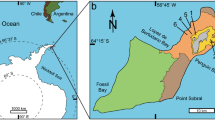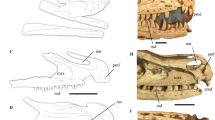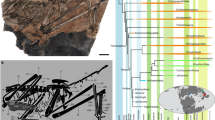Abstract
THE living pandas are restricted to the mountains of south-eastern Asia where both the giant panda (Aeluropoda) and the lesser panda (Ailurus) occur. They overlap in geographical range only in Szechuan, China, and there they are separated altitudinally, with the lesser panda favouring higher elevations1. Pleistocene records extend the range of the giant panda into Burma and eastern China, but the lesser panda has apparently not had a significantly wider range during the Quaternary2. Considerable controversy surrounds the phylogenetic relationships of both genera as they represent some of the most derived of terrestrial Carnivora. Recent marshalling of anatomical evidence on the giant panda has demonstrated its fundamental affinity with other members of the Ursidae3. The position of the lesser panda is equivocal although it is usually assigned to the Procyonidae. Procyonids are widely thought to be restricted to the New World, but recent work on various Oligocene and early Miocene forms in Europe4 and North America5 indicate that the procyonids had a Holarctic distribution at that time. Regardless of its broader phylogenetic affinity, the presence of medial and late Miocene relatives of the lesser panda in Pakistan and western Europe (Sivanasua Pilgrim, 1931=Schlossericyon Crusafont, 1959)6 and their absence in the New World makes an Old World origin for this group highly likely. Thus the discovery of a single tooth in North America almost identical to European specimens of the extinct lesser panda Parailurus is unexpected, and must be explained by immigration from Asia.
This is a preview of subscription content, access via your institution
Access options
Subscribe to this journal
Receive 51 print issues and online access
$199.00 per year
only $3.90 per issue
Buy this article
- Purchase on Springer Link
- Instant access to full article PDF
Prices may be subject to local taxes which are calculated during checkout
Similar content being viewed by others
References
Walker, E. P., Mammals of the World, 1187–1188 (Johns Hopkins University Press, Baltimore, 1964).
Kahlke, H. D., Vert. Palasiatica, 2, 83–108 (1961).
Davis, D. D., Fieldiana: Zool. Mem., 3, 1–339 (1964).
de Beaumont, G., Arch. Sci. Geneve, 21, 213–224 (1968).
Hough, J. R., Bull. Am. Mus. nat. Hist., 92, 67–118 (1948).
Crusafont-Pairo, M., Ann. Paleont., 45, 125–140 (1959).
Repenning, C. A., in The Bering Land Bridge (edit. by Hopkins, D. M.), 288–311 (Stanford University Press, California, 1967).
Bjork, P. R., Trans. Am. phil. Soc., 60, 1–54 (1970).
Geist, V., Quat. Res., 1, 283–315 (1971).
Fry, W. J., and Gustafson, E. P., J. Paleont., 48, 375–386 (1974).
Robertson, J. S., Bull. Fla St. Mus., 20, 111–186 (1976).
Newton, E. T., Q. Jl geol. Soc., London, 451 (1890).
Tobien, H., Z. Deutsch. geol. Ges., 104, 191 (1952).
Schlosser, M. Mitt. Jb. K. Ungar. Geol. Anst., 13, 67–86 (1899).
Berzi, A., Michaux, J., Hutchison, J. H., and Lindsay, E., Giorn. Geol., 35, 1–4 (1967).
Kormos, T., Mitt. Jb. K. Ungar. Geol. Anst., 30, 1–40 (1934).
Fejfar, O., Roz. Ustred. Ust. Geol., 30. 1–115 (1964).
Devjatkin, E. V., and Zazhigin, V. S., in Mesozoic and Cenozoic Faunas and Biostratigraphy of Mongolia 1, (edit. by Kramarenko, N. N.), 357–362 (Academy of Sciences, Moscow, 1974). in Russian.
Darofeyev, P. I., Paleont. Zh., 124–134 (1966), in Russian, English Trans., Int. geol. Rev., 8, 1109–1117 (1966).
Berggren, W. A., and Van Couvering, J., The Late Neogene …, 1–216 (Elsevier, Amsterdam, 1974).
Evernden, J. F., Savage, D. E., Curtis, G. H., and James, G. T., Am. J. Sci., 262, 145–198 (1964).
Bout, P., Palaeogeogr., Palaeoclim., Palaeoecol., 8, 95–106 (1970).
Author information
Authors and Affiliations
Rights and permissions
About this article
Cite this article
TEDFORD, R., GUSTAFSON, E. First North American record of the extinct panda Parailurus. Nature 265, 621–623 (1977). https://doi.org/10.1038/265621a0
Received:
Accepted:
Issue Date:
DOI: https://doi.org/10.1038/265621a0
This article is cited by
-
Two new carnivores from an unusual late Tertiary forest biota in eastern North America
Nature (2004)
-
The first carnivoran fauna from the Ruscinium (Early Pliocene, MN 15) of Germany
PalZ (2001)
-
Palaeontological and molecular views of panda phylogeny
Nature (1986)
-
Pliocene dispersal of the horse Equus and late Cenozoic mammalian dispersal events
Nature (1980)
Comments
By submitting a comment you agree to abide by our Terms and Community Guidelines. If you find something abusive or that does not comply with our terms or guidelines please flag it as inappropriate.



